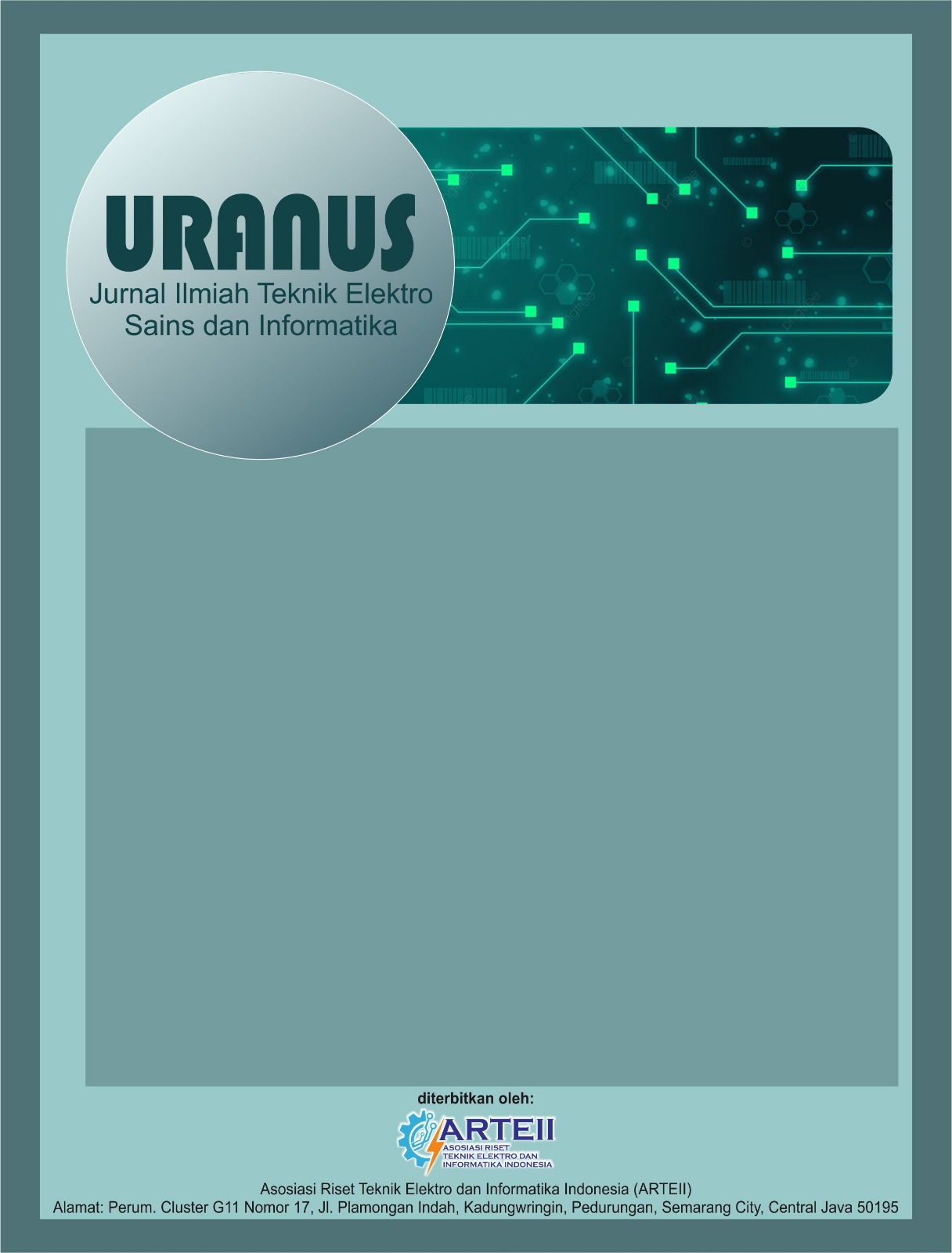Sistem Manajemen Baterai Pada Peralatan Catu Daya Di Equipment Room Stasiun Manggarai Dengan Aplikasi Blynk Berbasis Esp8266
DOI:
https://doi.org/10.61132/uranus.v2i3.270Keywords:
Battery Monitoring, ESP8266, INA219 SensorAbstract
This research aims to develop an efficient battery monitoring system using the ESP8266 module and INA219 sensor. Monitoring the battery condition effectively is crucial in various applications, especially in portable systems or isolated systems where real-time supervision is required. The method used in this research is the utilization of the ESP8266 module as the main microcontroller connected to the INA219 sensor to monitor the battery voltage, current, and power in real-time. The data obtained by the INA219 sensor is transmitted through the WiFi network managed by ESP8266 to a server or monitoring platform accessible to users via Blynk a web-based application or mobile application. The test results show that the system is capable of providing accurate information about the battery condition, including the charge level, usage current, and potential issues such as overcharge or undercharge. The implementation of this system is expected to be applicable in various applications, including renewable energy systems, portable devices, and electric vehicles, to improve battery performance and safety. The INA219 module as a voltage and current sensor found a voltage reading error percentage with a range of 0%-0.66% and an average of 0.18%. For readings at current with an error range of 0.91%-7.57%. For internal resistance readings which are calculated based on dividing the clamp voltage value by the circuit current, an error range of 0.04% -30.36% is found.
References
Agustanti, S. P., Hartini, & Nugraha, D. A. (2023). Perancangan sistem keamanan sepeda motor berbasis RFID mikrokontroler ESP8266. Jusikom: Jurnal Sistem Komputer Musi Rawas, 8(1), 19–29.
Erwanto, D., Widhining, D. A., & Sugiarto, T. (2020). Sistem pemantauan arus dan tegangan panel surya berbasis Internet of Things. Multitek Indonesia: Jurnal Ilmiah, 14(1), 1–12. http://journal.umpo.ac.id/index.php/multitek
Faizal, M., & Octaviano, A. (2023). Pemanfaatan IoT pada sistem atap otomatis berdasarkan cuaca dan waktu terintegrasi aplikasi Telegram berbasis NodeMCU. OKTAL: Jurnal Ilmu Komputer dan Science, 2(2), 429–439.
Fauzan, S., & Firmansyah, B. (2023). Rancang bangun smart parking pada area kost putra berbasis Arduino menggunakan QR-Code. JUNIFI: Jurnal Nasional Informatika, 3(1), 27–32.
Gillbert, H., & Hidayat, R. (2022). Design of a backup voltage supply in a medium-voltage cubicle control panel circuit when a blackout occurs from PLN. JEEE-U (Journal of Electrical and Electronic Engineering-UMSIDA, 6(1), 1–7. https://doi.org/10.21070/jeeeu.v6i1.1414
Hardianto, S., Hariyadi, S., & Hariyanto, D. (2022). Rancangan prototype control dan monitoring pembangkit listrik tenaga bayu berbasis mikrokontroler. *Seminar Nasional Inovasi Teknologi Penerbangan (SNITP), 1–9.
Ilhami, F., & Sokibi, P. (2019). Perancangan dan implementasi prototype kontrol peralatan elektronik berbasis Internet of Things menggunakan NodeMCU. Jurnal Digit, 9(2), 143–155.
Manahara, S., Putri, S. K., & Kencana, I. S. (2023). Tantangan transisi energi terbarukan di Indonesia (Studi kasus PLTS di Kabupaten Cilacap). JIMESE: Journal of Innovation Materials, Energy, and Sustainable Engineering, 1(1), 78–90. https://journal-iasssf.com/index.php/JIMESEJIMESE
Mulyana, A., Rahmawati, S., Rahman, R., & Permatasari, Z. N. (2022). Alat pengontrol perangkat elektronik berbasis IoT menggunakan Blynk dan Google Assistant. Journal of Computer Science and Technology (JCS-TECH), 2(1), 30–35. https://doi.org/10.54840/jcstech.v2i1.24
Revadiaz, E., Fatkhurrokhman, M., & Aribowo, D. (2022). Prototype automated manipulator robot menggunakan mikrokontroler NodeMCU ESP8266 berbasis Internet of Things (IoT). JTEV (Jurnal Teknik Elektro dan Vokasional, 8(2), 439–450. https://doi.org/10.24036/jtev.v8i2.117682
Setyawan, H., & Setiawan, A. N. K. (2021). Studi pengaruh salinitas air laut sintetis terhadap daya baterai sebagai energi alternatif terbarukan. Jurnal Teknik Elektro dan Komputasi (ELKOM), 3(1), 14–23. https://doi.org/10.32528/elkom.v3i1.4163
Sistem, J., & Tgd, K. (2023). Rancang alat pengontrol lampu ruangan menggunakan Telegram berbasis NodeMCU. Jurnal Sistem Komputer TGD, 2(5), 246–255. https://ojs.trigunadharma.ac.id/index.php/jskom
Soedjarwanto, N., Forda, G., & Nugroho, R. A. (2021). Prototipe smart door lock menggunakan motor stepper berbasis IoT (Internet of Things). Jurnal Rekayasa dan Teknologi Elektro, 15(2), 73–82.
Suwardi, S., Lidiawati, L., & Ayatullah, E. (2022). Rancang bangun data logger suhu dan kecepatan arus laut untuk praktikum oseanografi. Jurnal Pengelolaan Laboratorium Pendidikan, 4(2), 57–65.
Syamsudin, R. H., & Rusdinar, A. (2021). Pemantauan posisi dan kapasitas daya baterai pada automated guided vehicle menggunakan encoder dan voltage sensor. EProceedings of Engineering, 8(5).
Triyandi, E., Risma, P., Kusmanto, R. D., Dewi, T., & Oktarini, Y. (2021). Pembangkit energi listrik hybrid mini menggunakan turbin angin sumbu vertikal Savonius sebagai sumber energi alternatif. Journal of Applied Smart Electrical Network and Systems (JASENS), 2(2), 49–56.
Downloads
Published
How to Cite
Issue
Section
License
Copyright (c) 2024 Uranus : Jurnal Ilmiah Teknik Elektro, Sains dan Informatika

This work is licensed under a Creative Commons Attribution-ShareAlike 4.0 International License.





